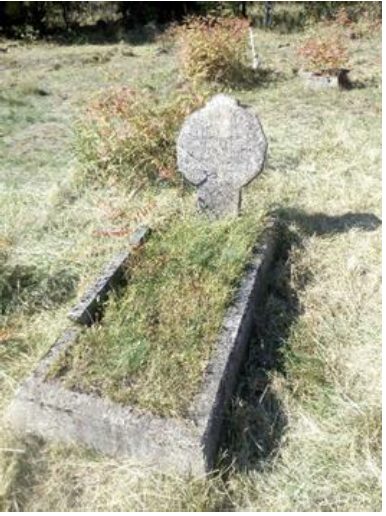Wilhelm Bogdan was buried in the center of the cemetery, to the left of the main path. The border is made of concrete, the gravestone has the shape of a cross and the inscription is still legible. In contrast to the very straight shape of the cross on the grave of Otto Trojan, this cross is clearly rounded and thus recognizable as a civilian war grave.[1]
Wilhelm Bogdan died when Russian soldiers tried to cross the Pissek River and came to Wilken. Johann Danielczik, a laborer from a neighboring village, was present at the incident and later testified under oath as a witness. He said that when the soldiers entered the village, he hid while fifteen-year-old Wilhelm Bogdan looked out the window to see what was happening outside. In the process, he was shot by one of the soldiers.[2]
The inscription on the grave of the young farmhand is also found on other graves, for example in Gutten [3] and in Ribittwen.[4] It was standardized and is not so much a realistic depiction of Wilhelm Bogdan’s circumstances of death, but shows how his death was perceived: as a heroic sacrifice for the fatherland.[5]
[1] Wiktor Knercer: Cmentarze wojenne z okresu I wojny światowej w wojewódźtwie olstyńskie, Warszawa 1995, p. 18, p. 21. – See Anna Długozima, Izabela Dymitryszyn und Edyta Winiarska-Lisiecka: Inwentaryzacja, analiza i waloryzacja nieużytkowanych cmentarzy ewangelickich w Nadleśnictwie Pisz. Wytyczne do rewaloryzacji i ochrony cmentarzy, Warsaw 2015, p. 59. – See Georg Büschges et al.: Wilken/Wilkenhof – Dorfgeschichten eines Friedhofs, in: Znad Pisy. Wydawnictwo poświęcone ziemi piskiej 27 (2021) – in print, no page given.
[2] Völkerrechtswidrige Handlungen der Russen im Kreis Johannisburg 1915 – 1916, Regierung Allenstein, Vol. 1, Archiwum Państwowe w Olsztynie (APO) MF 133848, sheet 670.
[3] Polish: Stare Guty.
[4] Polish: Rybitwy. Vgl. Długozima, Dymitryszyn und Winiarska-Lisiecka: Inwentaryzacja, p. 58.
[5] Büschges u.a.: Wilken/Wilkenhof – in print, no page given.
